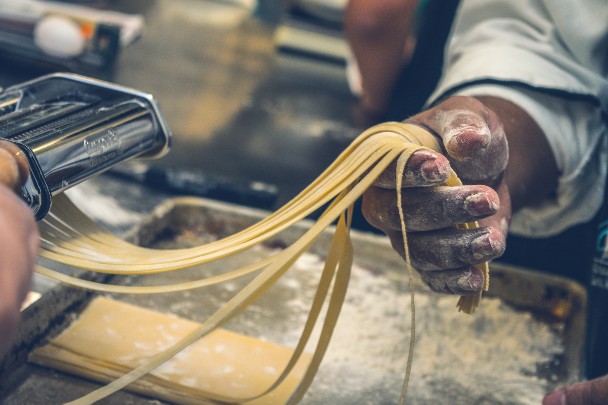May 17, 2024 Industry news
The UK’s food and drink industry is an economic powerhouse. Valued at over £104 billion, it employs more than 4.2 million people and is the country’s biggest manufacturing sector - larger than the automotive and aerospace industries combined.
On average, UK households spend over 11 per cent of their total expenditure of food and drink, making it the 4th highest expenditure after housing, fuel and power, transport and other expenditure items. In 2022 alone, the total value of UK manufacturers’ product sales came in just under £430 billion, highlighting the scale of the opportunity available to any brand that is able to break into to this highly lucrative market.
That is why we spoke to two thriving food and drink start-ups, Diistil and Superfoodio, to discuss how to start a business, drive growth and more. Read on for a summary of our key takeaways.

The basics
Start by identifying your USP. Does your product fill a gap in the market, meet a specific consumer need, offer something new, does your brand have a mission or purpose that will have a strong appeal for certain audiences? Understanding of where your product sits withing the broader context of its specific category will help you find your niche.
Your top priority should obviously be developing a high-quality product that tastes delicious. After all, this is the very foundation of your business so you need to ensure your recipes are consistent and use top quality ingredients.
Carefully sourcing these ingredients, learning about their provenance and understanding your supply chain is crucial so you will want to develop good relationships with any suppliers you partner with along the way.
Test and refine your products and proposition. Conduct taste tests with potential customers and gather feedback wherever you can, including from friends and family! No one gets it perfect the first time so be prepared to iterate and adapt based on the feedback you receive and remember; the food and drink market is crowded so focus on what makes your product unique.
Getting started
You may have started off making your products in your home kitchen or a rented space but, at some point, you are going to want to scale up your operations. This often involved working with suppliers or manufacturers but how do you go about finding them?
Start by listing all the ingredients you need, considering factors like quality, consistency, organic or conventional options, and sourcing locations. The consider your production requirements. Do you need someone to produce your entire product or just specific parts? Will there be minimum order quantities, what are your packaging needs and will you have any special processing requirements?
Once you have this all laid out, it is time to start your search. You could use online directories specific to the food and drink industry, contact the relevant trade association for your product category, attend food shows or trade events, or join a business community such as Enterprise Nation or Bread & Jam.

Suppliers & manufacturers
You really should aim to find suppliers and manufacturers that share your values so do your research.
Make sure they prioritise quality control, food safety and have the relevant certifications.
Consider your production volume and cash flow.
Some suppliers might have high minimum order quantities that won’t be suitable for a new brand starting small.
If sustainability is a priority for your brands, speak to suppliers to see if they have a commitment to ethical sourcing and environmentally friendly practices. This will not only allow you to ensure you are aligned, it will enable you to more effectively share the sustainability credentials of your brand and products with consumers.
Once you have found the perfect candidate, carefully review and negotiate the terms of the contract to ensure it covers things like pricing, quality specifications, delivery schedules, payment terms etc., and maintain an open and honest dialog to build trust. Developing a strong, collaborative relationship will be key for long term success. Be fully transparent about your needs and expectations from the start.
Build a strong team
Both Diistil and Superfoodio agree that investing in building a strong team is hugely important.
New brands typically have limited resources so being able to leverage the knowledge and skills of multiple people can really help maximise the impact you are trying to achieve. The food and drink industry is fast paced. A strong team can help you adapt to changing market dynamics and navigate growth efficiently.
Look for new team members that can fill knowledge gaps. This might include product development, marketing, sales, operations, finance, and legal knowledge etc – any areas of expertise you don’t have in house.
New businesses typically have limited resources. Building a diverse team allows you to leverage the combined knowledge and skills of multiple people, fosters creativity and innovation, and will help you more effectively address any challenges or opportunities come your way. It will also free up your time to focus on strategic decisions and building your brand.

The route to market
Choosing the right route to market is another important decision facing any new food and drink brand. This will determine how you reach your target audience and get your product onto their shelves, screens or in their baskets. First, you want to consider your customer. Who is your ideal customer? Where do they shop and what are their purchasing habits?
You then need to look at your product’s characteristics. What is its shelf life? Is if fragile? What is your pricing strategy? Does it require refrigeration or special handling?
Whether it’s selling D2C, on online marketplaces, grocery retailer, wholesaler, specialty store or farm shop, there are many options to choose from, but these factors will influence your options.
Getting out there
Whichever option you chose, it is essential that focus on getting your products out there and raising awareness early on. If you are struggling to break through with supermarket buyers or distributors, direct sales or online marketplaces might be easier entry points.
Whilst you do want your launch to be a success, don’t lose sight of your long-term goals as your growth potential and national or export expansion plans could also influence your decision.
Once you have embarked on your chosen route to market, develop good relationships with your supply chain partners as collaborating with them will benefit you massively. If you are fortunate enough to secure a retail listing, see if the retailer will work with you on promotion and driving sales. If not, developing you own marketing, promotional and social media will help you drive awareness and growth.
Finally, always provide your customers with the best possible experience wherever you can. A great product combined with great customers service and a strong brand identity is almost certain to build consumer loyalty and encourage repeat purchases.



